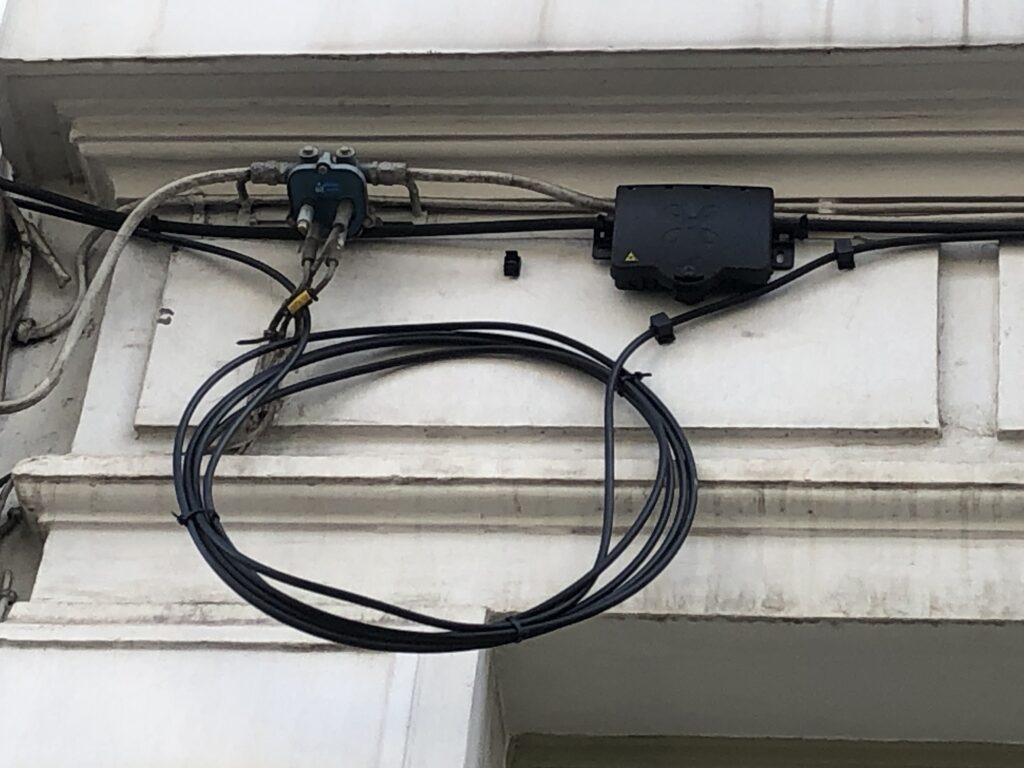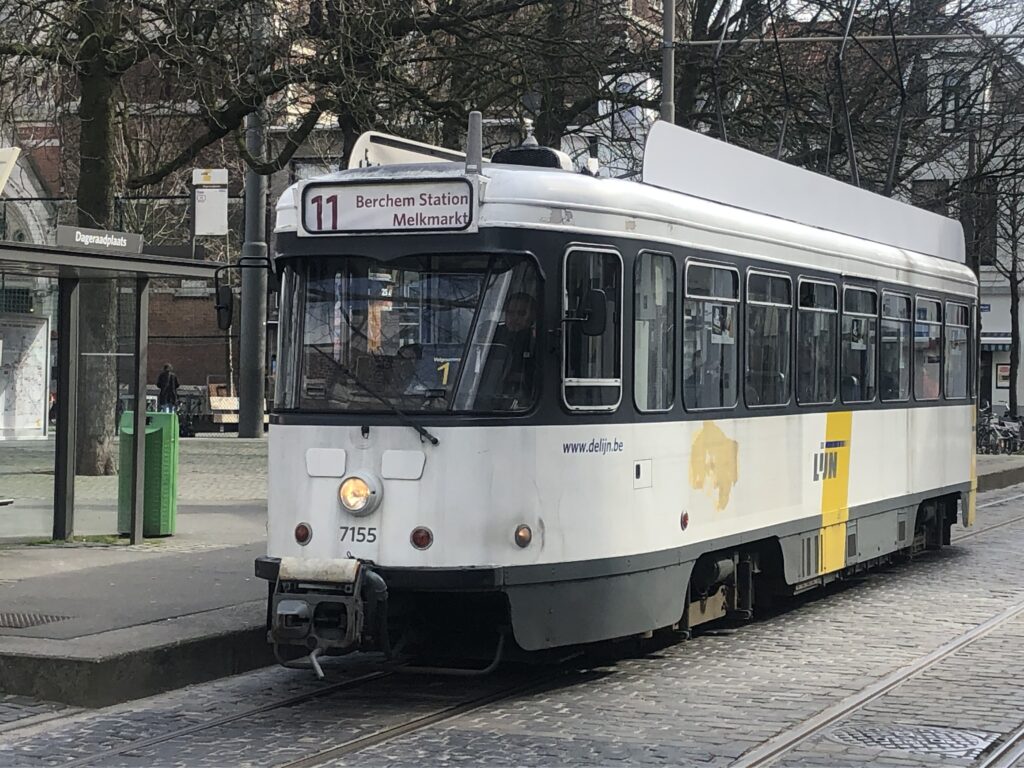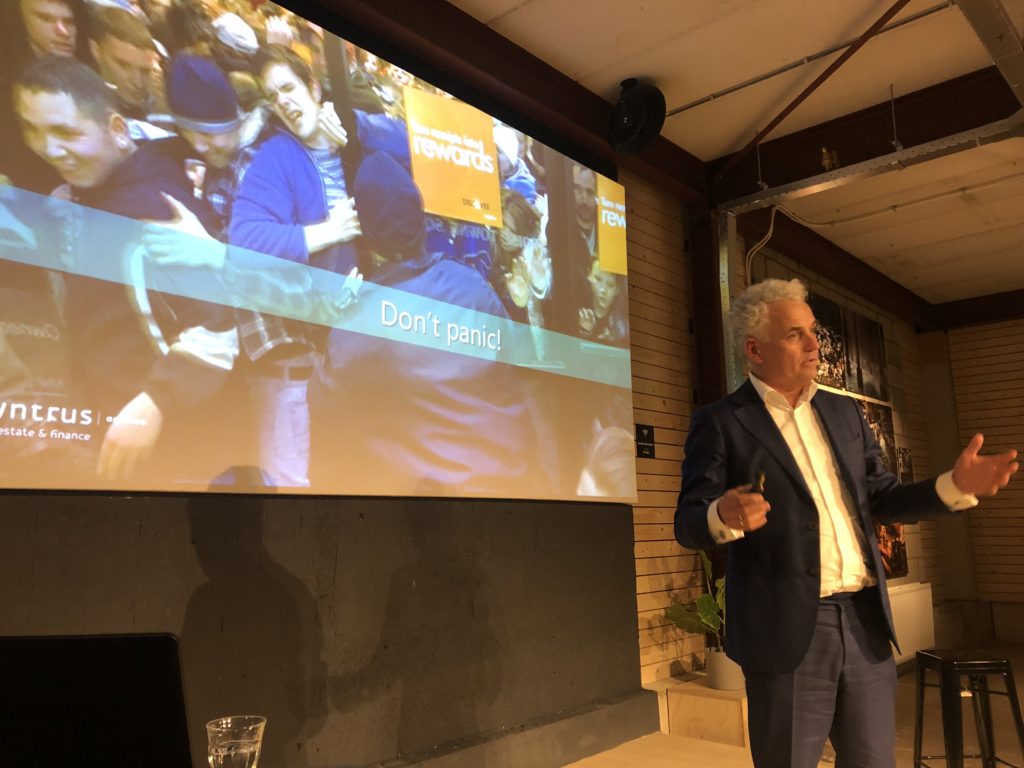Oct 11, 2020 | Articles
Article in Gazet Van Zurenborg local Antwerp newspaper. It seemed as if there had been a dam breach in the Waterloostraat among other streets in the historic Zurenborg neighbourhood in Antwerp on 16 August 2020. Heavy rain showers with extreme rainfall made the street flooded. The amount of rainfall was too much for the sewage system and the soil absorption capacity was too limited. Less visible from the street, but no less disastrous, was the extensive damage in a number of cellars. The pressure of the water caused entire floors to rise and cracks in the walls. This article (in Dutch) elaborates on the background of the events and possible directions for solutions to make the area more water-sensitive.
Link to article gvz-05-hko
Sep 1, 2020 | Articles
Those who walked recently in the vicinity of the Dageraadplaats Square in the heart of Zurenborg and looked up to the mostly beautiful facades of Zurenborg will probably have noticed: new black cables fixed on the facade with also here and there small network cabinets. The first steps to a fiberglass covered Zurenborg. The new black cables are being laid by Fluvius as part of a pilot project for construction of a fiber optic network that is ultimately to cover the entire Flanders. Article in the Antwerp newspaper Gazet van Zurenborg (in Dutch) about the background and the plans.
Link to article gvz-04-hko

Jul 31, 2020 | Articles
Covid-19 has accelerated pre-existing trends in real estate driving a need to repurpose or reposition assets such as shopping centres and office blocks, creating a historic opportunity for investors to add value and redefine urban landscapes. Article in Living Retail.
Link to article 38-41 Living Retail July 2020 hko
Jul 1, 2020 | Articles
So many functions in an area of 50 by 60 meters! How do we ever get that arranged smoothly? Ask casual passers-by or residents. Hardly anyone is satisfied with the Mayor Edgar Ryckaert Square, or for many simply the Station Square. Too busy, too chaotic, too ugly and too much in too limited a space. Article in Antwerp newspaper Gazet Van Zurenborg (in Dutch) explaining the current situation and what can be done about it.
Link to article gvz-03-hko
Apr 11, 2020 | Articles
Article in Antwerp paper Gazet Van Zurenborg, 2020 nr 2, March-April issue. The Zurenborg neighbourhood and the Antwerp tram are historically closely intertwined. The tram was the link that made Zurenborg as new residential area attractive for the Antwerp bourgeoisie in the late 19th century. And Zurenborg was the starting point for tram lines connecting Antwerp to the region around the city for a long time. While the tram running from Dageraadplaats to the City Park was cancelled a long time ago, tram line 11 still sets the tone in the Zurenborg area. What covers the Tramnet 2020 Antwerp public transport plan, and what are the implications of the plan for our neighbourhood. Article in Dutch.
Link to article gvz-02-hko

Dec 5, 2019 | Articles
From Neighbourhood Shopping Centre to Heart of the Neighbourhood. CPD Session organised by RICS NL Research & Innovation Committee which took place in New Metropolis, in the Amsterdamse Poort shopping centre, in Amsterdam on 3rd December. Hosted by CBRE Global Investors and moderated by Paul Wessels (Property NL), the session was about the enormous ongoing transformation task of small and midsize neighbourhood and district shopping centres in the Netherlands.
As kick-off was a guided walk through Amsterdamse Poort by Bas Buvelot (CBRE GI) and Robèrt Dackus (3W) to see the ongoing transformation of the Amsterdamse Poort area. Driven by the disruption in the retail and boosted by very strong demographics in the area and a fast growing excellent accessible business hub, the Amsterdamse Poort is being transformed into a true mixed use centre, conceptualised as a central urban quarter embedded in a quality public realm with all functions one would expect in a town centre. Retail is just one of them. With a very diverse wider catchment area, the challenge is to maintain a balance so that the area will be relevant for the total population.
Egbert Fransen (Pakhuis De Zwijger / New Metropolis) welcomed the delegates with an inspiring opening statement on ‘Creating the City and the Real Estate Sector’. Emphasising on a fear of an accelerating gentrification process throughout Amsterdam linked to massive shortages in the housing market, Fransen argued for more affordable housing construction and advised investors not to focus too much on profit generation on ground floor positions in buildings as that tends to have a negative impact on variety and diversity. Variety and diversity in retail, F&B, and services is one of the pillars of keeping a city open to all.
Gertjan Slob (Locatus) provided the audience with an overview of the state of the retail market. Overall, vacancies are up, variety of supply is declining on many locations, bankruptcies of retailers have had a significant impact, and retail chains are shredding less relevant stores. While prime locations in the largest cities and proximity convenience have been relatively resilient so far, especially mid-size locations are under pressure, whether mid-size town centres or district centres in and around the largest cities. Leisure and F&B are growing in importance, but a further shift toward multifunctional centres and blurring within individual units is underway.
Boris Van der Gijp (Syntrus Achmea) elaborated on Syntrus’ retail investment strategy. Syntrus is weathering the disruption in retail quite well. A clear strategy, extensive research, and a check system to evaluate whether opportunities are in line with the strategy and do have strong fundamentals is key. Investing in the right properties does in general result into good returns. Syntrus Achmea strongly believes in neighbourhood convenience centres, but is highly critical on fundamentals, catchment area dynamics, and conceptual arrangements, typically the ‘hardware’ which is difficult to be changed. Via a top-down research led assessment, Syntrus mapped all neighbourhood convenience centres in the country and does have a clear initial view on which ones to consider and which ones not. Active and creative asset management is in many cases focused on repositioning a shopping centres into a ‘living room’ for the neighbourhood, and is essential to further improve assets in ownership, make them more resilient, and increase their value.
Last but not least, ‘fireplace chat’ interview by me with Marcel Kokkeel (GLOW Real Estate bv). Having worked with companies like Citycon, Multi Corporation, Bouwfonds, and Ahold, Marcel has a massive international experience and understands very well the language of real estate owners, retailers and customers alike. Having been CEO at Citycon in Finland for more than 8 years before returning to the Netherlands early 2019, he sees that the retail sector in the Netherlands has to make major restructurings to stay relevant for the customer, and, though there is progress in transforming shopping centres into town centre concepts, still a lot is to be learned about integrated mixed use, bringing all facilities together which neighbourhood and district residents expect in their centre. For several reasons, including urban planning and climate, integrated neighbourhood and district concepts are well advanced in the Nordics, including Citycon examples as Iso Omena near Helsinki and Liljeholmstorget in Stockholm. A balanced integration of commercial and public functions in a high-quality public realm, well embedded in the urban neighbourhood fabric, with very good public transport access, contribute to a sense of town centre feeling an increase the relevance of the centre for the customer. This requires investment and also realistic rent expectations. Better to digest the pill now than to wait. ‘Dying in Slow Motion or Act with Speed’. Owners have to think in terms of ‘people’s centres’, accepting that a place belongs to the people who use the area and consume there. And municipalities can’t sit back any longer, active facilitation is needed improve the relevance of centre areas. The Amsterdamse Poort area makes Marcel enthusiastic, a well located area with very good access and a strong market growth and strong actors in the driver’s seat. A potential Iso Omena style urban mixed-use town centre reference for the Netherlands. Not surprisingly, through his company GLOW and with his relevant international experience and local knowledge, Marcel is servicing investors and getting involved in the transformation of shopping centres with relevance and good fundamentals, but in need of a thorough transformation into a ‘peoples centre’, such as in Alphen aan de Rijn.
The Research & Innovation Professional Group of RICS Netherlands has been active since 2015, and is organising CPD seminars and events on a regular basis. The Group aims to reinforce standards by which research in the property sectors is being undertaken, act as sharing platform for research practices and methods, and to make RICS related research reports accessible to the wider RICS community. The Group has currently 8 members who are member on an independent basis, are active in different sectors in the property market.

Shopper Hall – Amsterdamse Poort

Boris van der Gijp speaking at RICS CPD

RICS CPD at New Metropolis





